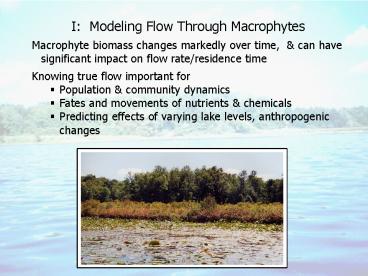I: Modeling Flow Through Macrophytes - PowerPoint PPT Presentation
1 / 8
Title:
I: Modeling Flow Through Macrophytes
Description:
Can it allow plankton to remain 'indefinitely'? Part II: Incorporating Plankton Behavior ... Combing hydrodynamic model with agent-based model for plankton behavior ... – PowerPoint PPT presentation
Number of Views:101
Avg rating:3.0/5.0
Title: I: Modeling Flow Through Macrophytes
1
- I Modeling Flow Through Macrophytes
- Macrophyte biomass changes markedly over time,
can have significant impact on flow
rate/residence time - Knowing true flow important for
- Population community dynamics
- Fates and movements of nutrients chemicals
- Predicting effects of varying lake levels,
anthropogenic changes
2
Approach
- Modify existing hydrodynamic model (SI3D) to
incorporate macrophytes - Check results against experimental data -
velocities, drag, etc. - Use modified model to investigate how presence of
macrophytes changes water residence time - range of embayment size/geometry
- range of macrophyte abundance and locations
within embayment
3
Nepf and Vivoni (2000) Channel flow over plastic
plants
4
Part II Incorporating Plankton Behavior
To what extent does migration affect washout?
Can it allow plankton to remain "indefinitely"?
5
Normal migration Reverse migration No
migration
6
MODELING APPROACH
- Combing hydrodynamic model with agent-based model
for plankton behavior - Investigate plausible migration behaviors under
different flow regimes - (Future) Model real embayment geometry, and
compare with field data - Diurnal and depth-specific sampling of
zooplankton - Dye experiments
7
- Integration I BioEE 760 Readings in
Biocomplexity Fall '02 - Targeted at project students
- Theme analysis of large-scale patterns, where
experimental manipulations to test hypotheses are
not feasible - Untangling Ecological Complexity The
Macroecological Approach, by Brian Maurer - Recent papers on, e.g.,
- Scaling analyses of large-scale data sets (BBS,
Gentry) - Agent-based and spatial models for complex
systems - Food web analysis
8
Integration II "How can we analyze our data?"
- Weekly discussion group for project members
- Start Fall '03, continue if other PIs rotate in
as "host". - We will
- Brainstorm on individual collaborative analyses
and modeling - Read papers with direct relevance to potential
data analyses and modeling - Present and discuss progress on analyses
- Respect data ownership. Any analyses will require
explicit approval from the data generators, and
will give them the option to participate in the
analysis (and then coauthor any resulting
publications).































